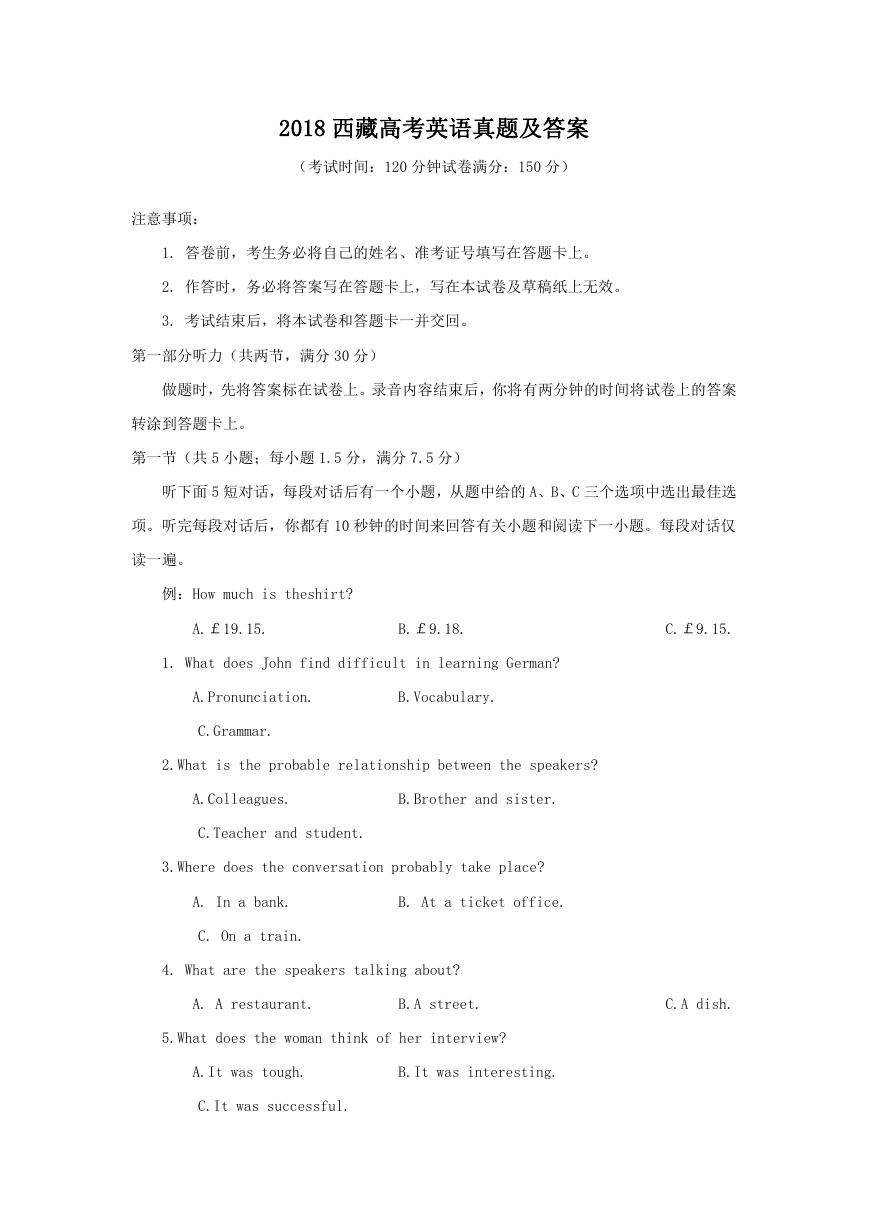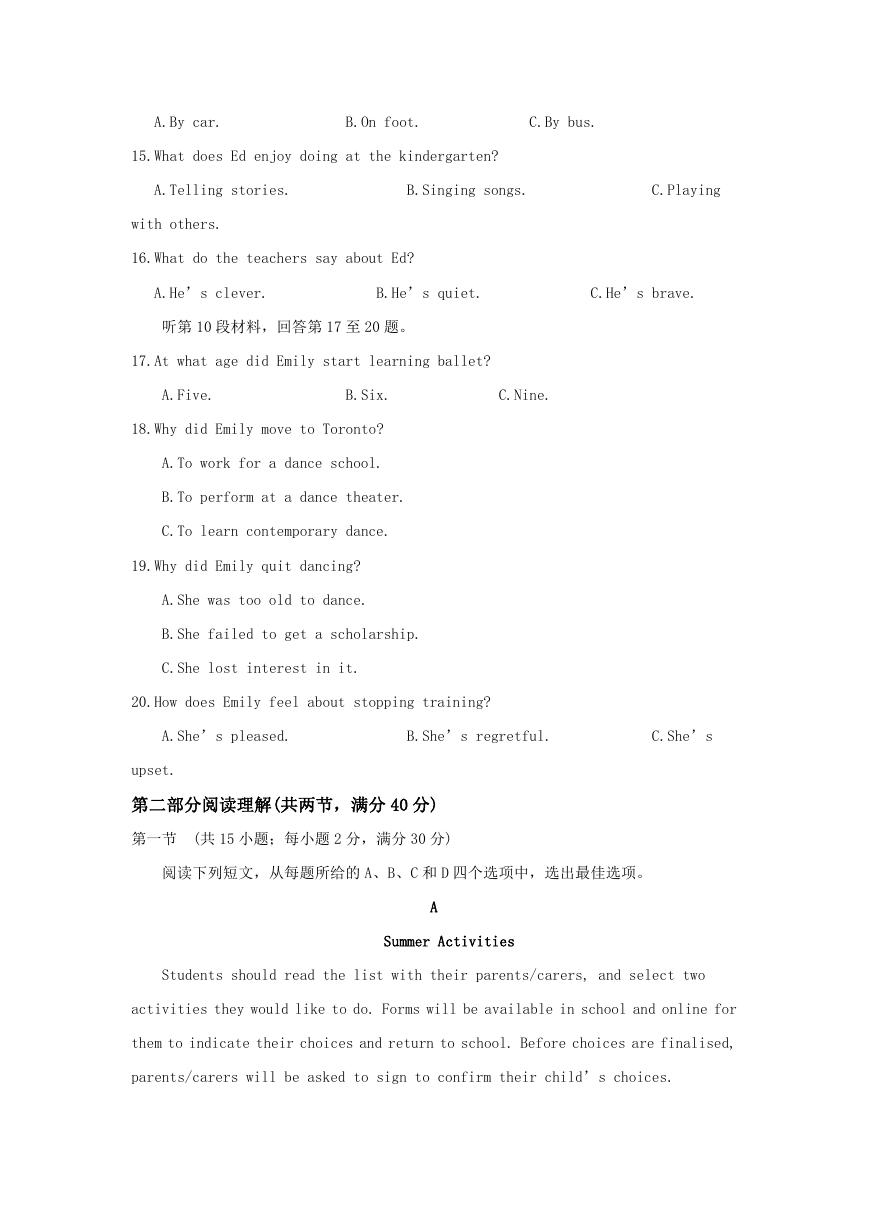2018 西藏高考英语真题及答案
(考试时间:120 分钟试卷满分:150 分)
注意事项:
1. 答卷前,考生务必将自己的姓名、准考证号填写在答题卡上。
2. 作答时,务必将答案写在答题卡上,写在本试卷及草稿纸上无效。
3. 考试结束后,将本试卷和答题卡一并交回。
第一部分听力(共两节,满分 30 分)
做题时,先将答案标在试卷上。录音内容结束后,你将有两分钟的时间将试卷上的答案
转涂到答题卡上。
第一节(共 5 小题;每小题 1.5 分,满分 7.5 分)
听下面 5 短对话,每段对话后有一个小题,从题中给的 A、B、C 三个选项中选出最佳选
项。听完每段对话后,你都有 10 秒钟的时间来回答有关小题和阅读下一小题。每段对话仅
读一遍。
例:How much is theshirt?
A.£19.15.
B.£9.18.
C.£9.15.
1. What does John find difficult in learning German?
A.Pronunciation.
B.Vocabulary.
C.Grammar.
2.What is the probable relationship between the speakers?
A.Colleagues.
B.Brother and sister.
C.Teacher and student.
3.Where does the conversation probably take place?
A. In a bank.
B. At a ticket office.
C. On a train.
4. What are the speakers talking about?
A. A restaurant.
B.A street.
C.A dish.
5.What does the woman think of her interview?
A.It was tough.
B.It was interesting.
C.It was successful.
�
第二节(共 15 小题;每小题 1.5 分,满分 22.5 分)
听下面 5 段对话或独白,每段对话或独白后有几个小题,从题中所给的 A、B、C 三个选
项中选出最佳选项。听每段对话或独白前,你将有时间阅读各个小题,每小题 5 秒钟;听完
后,各小题将给出 5 秒钟的作答时间。每段对话或独白读两遍。
听第 6 段材料,回答第 6、7 题。
6.When will Judy go to a party?
A.On Monday.
B.On Tuesday.
C.On Wednesday.
7.What will Max do next?
A.Fly a kite.
B.Read a magazine.
C.Do
his
homework.
听第 7 段材料,回答第 8、9 题。
8.What does the man suggest doing at first?
A.Going to a concert.
B.Watching a movie.
C.Playing
a
computer game.
9.What do the speakers decide to do?
A.Visit Mike.
B.Go boating.
C.Take
a
walk.
听第 8 段材料,回答第 10 至 12 题。
10.Which color do cats see better than humans?
A.Red.
B.Green.
C.Blue.
11.Why do cats bring dead birds home?
A.To eat them in a safe place.
B.To show off their hunting skills.
C.To make their owners happy.
12.How does the man sound at the end of the conversation?
A.Grateful.
B.Humorous.
C.Curious.
听第 9 段材料,回答第 13 至 16 题。
13.Who is Macy?
A.Ed’s mother.
B.Ed’s teacher.
C.Ed’s friend.
14.How does Ed usually go to kindergarten?
�
A.By car.
B.On foot.
C.By bus.
15.What does Ed enjoy doing at the kindergarten?
A.Telling stories.
B.Singing songs.
C.Playing
with others.
16.What do the teachers say about Ed?
A.He’s clever.
B.He’s quiet.
C.He’s brave.
听第 10 段材料,回答第 17 至 20 题。
17.At what age did Emily start learning ballet?
A.Five.
B.Six.
C.Nine.
18.Why did Emily move to Toronto?
A.To work for a dance school.
B.To perform at a dance theater.
C.To learn contemporary dance.
19.Why did Emily quit dancing?
A.She was too old to dance.
B.She failed to get a scholarship.
C.She lost interest in it.
20.How does Emily feel about stopping training?
A.She’s pleased.
B.She’s regretful.
C.She’s
upset.
第二部分阅读理解(共两节,满分 40 分)
第一节 (共 15 小题;每小题 2 分,满分 30 分)
阅读下列短文,从每题所给的 A、B、C 和 D 四个选项中,选出最佳选项。
A
Summer Activities
Students should read the list with their parents/carers, and select two
activities they would like to do. Forms will be available in school and online for
them to indicate their choices and return to school. Before choices are finalised,
parents/carers will be asked to sign to confirm their child’s choices.
�
Activity
Description
Member
Cost
of staff
Outdoor
Take yourself out of your comfort zone
Mr.
£140
Adventure
for a week, discover new personal qualities,
Clemens
(OUT)
and learn new skills. You will be able to take
part in a number of activities from canoeing
to wild camping on Dartmoor. Learn rock
climbing and work as a team, and enjoy the
great outdoor environment.
WWI
On Monday we travel to London. After
Mrs.
£425
Battlefields
staying overnight in London, we travel on Day
Wilson
and Paris
2 to northern France to visit the World War
(WBP)
I battlefields. On Day 3 we cross into
Belgium. Thursday sees us make the short
journey to Paris
where we
will
visit
Disneyland Paris park, staying until late to
see the parade and the fireworks. Our final
day, Friday, sees us visit central Paris and
tour the main sights.
Crafty
Four days of product design centred
Mrs.
£30
Foxes
around textiles. Making lovely objects using
Goode
(CRF)
recycled and made materials. Bags, cushions
and decorations...Learn skills and leave
with modern and unusual textiles.
Potty
Visit Warner Bros Studio, shop stop to
Miss
£150
about Potter
buy picnic, stay overnight in an approved
Drake
(POT)
Youth Hostel in Streatley-on -Thames, guided
tour of Oxford to see the film locations,
picnic
lunch
outside
Oxford’s
�
Christchurch, boating on the River Cherwell
through the University Parks, before heading
back to Exeter.
21.Which activity will you choose if you want to go camping?
A.OUT.
B.WBP.
C.CRF.
D.POT.
22.What
will
the
students do
on
Tuesday
with
Mrs.
Wilson?
A. Travel
to
London.
See
a
parade
and
fireworks.
C. Tour
central
Paris.
Visit
the
WWI
battlefields.
B.
D.
23.How
long does
Potty
about
Potter
last?
A. Two
days.
B. Four
days.
C. Five
days.
D. One
week.
B
Many of us love July because it’s the month when nature’s berries and stone
fruits are in abundance. These colourful and sweet jewels from British Columbia’s
fields are little powerhouses of nutritional protection.
Of the common berries, strawberries are highest in vitamin C, although, because
of their seeds, raspberries contain a little more protein(蛋白质), iron and zinc
(not that fruits have much protein). Blueberries are particularly high in
antioxidants(抗氧化物质). The yellow and orange stone fruits such as peaches are
high in the carotenoids we turn into vitamin A and which are antioxidants. As for
cherries(樱桃), they are so delicious who cares? However, they are rich in vitamin
C.
When combined with berries of slices of other fruits, frozen bananas make an
excellent base for thick, cooling fruit shakes and low fat "ice cream". For this
purpose, select ripe bananas for freezing as they are much sweeter. Remove the skin
and place them in plastic bags or containers and freeze. If you like, a squeeze of
fresh lemon juice on the bananas will prevent them turning brown. Frozen bananas
�
will last several weeks, depending on their ripeness and the temperature of the
freezer.
If you have a juicer, you can simply feed in frozen bananas and some berries
or sliced fruit. Out comes a
"soft-serve" creamy dessert, to be eaten right away. This makes a fun activity
for a children’s party; they love feeding the fruit and frozen bananas into the
top of the machine and watching the ice cream come out below.
24. What does the author seem to like about cherries?
A. They contain protein.
B. They are high in vitamin
A.
C. They have a pleasant taste.
D. They are rich in
antioxidants.
25. Why is fresh lemon juice used in freezing bananas?
A. To make them smell better.
B. To keep their
colour.
C. To speed up their ripening.
D. To improve their
nutrition.
26. What is "a juicer" in the last paragraph?
A. A dessert.
C. A container.
27. From which is the text probably taken?
A. A biology textbook.
magazine.
C. A research paper.
brochure.
B. A drink.
D. A machine.
B.
D.
A
A
health
travel
C
Teens and younger children are reading a lot less for fun, according to a Common
Sense Media report published Monday.
While the decline over the past decade is steep for teen readers, some data in
the report shows that reading remains a big part of many children’s lives, and
�
indicates how parents might help encourage more reading.
According to the report’s key findings, "the proportion(比例) who say they
‘hardly ever’ read for fun has gone from 8 percent of 13-year-olds and 9 percent
of 17-year-olds in 1984 to 22 percent and27 percent respectively today."
The report data shows that pleasure reading levels for younger children, ages
2—8,remain largely the same. But the amount of time spent in reading each session
has declined, from closer to an hour or more to closer to a half hour per session.
When it comes to technology and reading, the report does little to counsel(建
议)parents looking for data about the effect of e-readers and tablets on reading.
It does point out that many parents still limit electronic reading, mainly due to
concerns about increased screen time.
The most hopeful data shared in the report shows clear evidence of parents
serving as examples and important guides for their kids when it comes to reading.
Data shows that kids and teens who do read frequently, compared to infrequent readers,
have more books in the home, more books purchased for them, parents who read more
often, and parents who set aside time for them to read.
As the end of school approaches, and school vacation reading lists loom(逼
近)ahead, parents might take this chance to step in and make their own summer reading
list and plan a family trip to the library or bookstore.
28. What is the Common Sense Media report probably about?
A. Children’s reading habits.
B.
Quality
of
children’s books.
C. Children’s after-class activities.
D.
Parent-child
relationships.
29. Where can you find the data that best supports "children are reading a lot less
for fun"?
A. In paragraph 2.
C. In paragraph 4.
B. In paragraph 3.
D. In paragraph 5.
30. Why do many parents limit electronic reading?
A. E-books are of poor quality.
B. It could be a waste of
�
time.
C. It may harm children’s health.
D.
E-readers
are
expensive.
31. How should parents encourage their children to read more?
A. Act as role models for them.
B. Ask them to write book
reports.
C. Set up reading groups for them.
D.
Talk
with
their
reading class teachers.
D
We’ve all been there: in a lift, in line at the bank or on an airplane, surrounded
by people who are, like us, deeply focused on their smartphones or, worse, struggling
with the uncomfortable silence.
What’s the problem? It’s possible that we all have compromised conversational
intelligence. It’s more likely that none of us start a conversation because it’s
awkward and challenging, or we think it’s annoying and unnecessary. But the next
time you find yourself among strangers, consider that small talk is worth the trouble.
Experts say it’s an invaluable social practice that results in big benefits.
Dismissing small talk as unimportant is easy, but we can’t forget that deep
relationships wouldn’t even exist if it weren’t for casual conversation. Small
talk is the grease( 润 滑 剂 ) for social communication, says Bernardo Carducci,
director of the Shyness Research Institute at Indiana University Southeast. "
Almost every great love story and each big business deal begins with small talk,"
he explains. "The key to successful small talk is learning how to connect with
others, not just communicate with them."
In a 2014 study, Elizabeth Dunn, associate professor of psychology at UBC,
invited people on their way into a coffee shop. One group was asked to seek out an
interaction(互动) with its waiter; the other, to speak only when necessary. The
results showed that those who chatted with their server reported significantly
higher positive feelings and a better coffee shop experience. "It’s not that
talking to the waiter is better than talking to your husband," says Dunn. "But
�
















 2023年江西萍乡中考道德与法治真题及答案.doc
2023年江西萍乡中考道德与法治真题及答案.doc 2012年重庆南川中考生物真题及答案.doc
2012年重庆南川中考生物真题及答案.doc 2013年江西师范大学地理学综合及文艺理论基础考研真题.doc
2013年江西师范大学地理学综合及文艺理论基础考研真题.doc 2020年四川甘孜小升初语文真题及答案I卷.doc
2020年四川甘孜小升初语文真题及答案I卷.doc 2020年注册岩土工程师专业基础考试真题及答案.doc
2020年注册岩土工程师专业基础考试真题及答案.doc 2023-2024学年福建省厦门市九年级上学期数学月考试题及答案.doc
2023-2024学年福建省厦门市九年级上学期数学月考试题及答案.doc 2021-2022学年辽宁省沈阳市大东区九年级上学期语文期末试题及答案.doc
2021-2022学年辽宁省沈阳市大东区九年级上学期语文期末试题及答案.doc 2022-2023学年北京东城区初三第一学期物理期末试卷及答案.doc
2022-2023学年北京东城区初三第一学期物理期末试卷及答案.doc 2018上半年江西教师资格初中地理学科知识与教学能力真题及答案.doc
2018上半年江西教师资格初中地理学科知识与教学能力真题及答案.doc 2012年河北国家公务员申论考试真题及答案-省级.doc
2012年河北国家公务员申论考试真题及答案-省级.doc 2020-2021学年江苏省扬州市江都区邵樊片九年级上学期数学第一次质量检测试题及答案.doc
2020-2021学年江苏省扬州市江都区邵樊片九年级上学期数学第一次质量检测试题及答案.doc 2022下半年黑龙江教师资格证中学综合素质真题及答案.doc
2022下半年黑龙江教师资格证中学综合素质真题及答案.doc